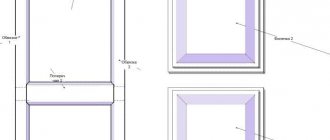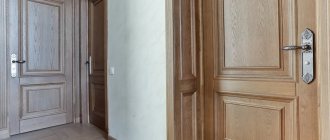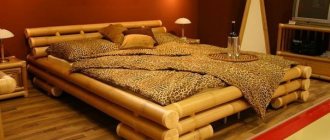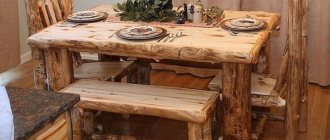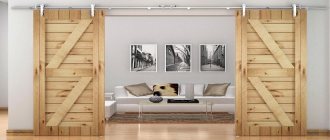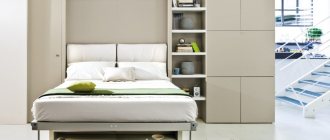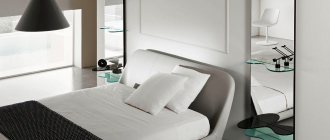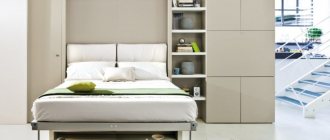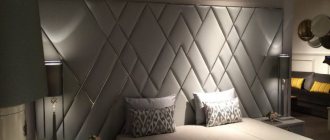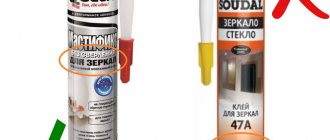Mirrors have firmly entered our lives, making it more interesting and informative. It is thanks to them that people get the opportunity to study their appearance in detail, visually expand the space, fill the room with additional light and a special aura. Once again looking at his reflection, sooner or later any person wonders how a mirror is made and why it is endowed with a magical nature. An interesting history of the creation of reflective surfaces, which dates back to the development of civilization, will help you understand these issues.
Basic design
The mirror is a glass surface of varying degrees of purity, which is connected to a layer of reflective coating - amalgam. Surprisingly, the production of interior items familiar to modern people began not so long ago, although reflective surfaces were often found during excavations of ancient palaces, burial places of royalty, aristocrats, and noble people. Often these objects were exquisitely decorated with precious stones, and the handles of some specimens were made of ivory. Today it is difficult to even imagine that such a familiar household item could once have been an unacceptable luxury for most people.
In 1279, Franciscan John Peckham described how a mirror was made by treating glass with a thin layer of lead. This method of obtaining a reflective surface was not easy and even dangerous, since it involved the use of mercury. The product itself was not of high quality and had a cloudy surface. Despite all the shortcomings, it was this technology for the production of mirrors that was used without significant changes almost until 1835.
The production of modern accessories based on glass and reflective coatings began only after the industrial revolution. Since that time, production technology has remained virtually unchanged. Nowadays, two methods of making mirrors are popular:
- spraying aluminum, titanium, as well as other metals and alloys onto the glass surface;
- production of products from a silver solution, which is fixed with a layer of copper or special chemicals.
Another method that allows you to obtain a flexible, unbreakable surface is the deposition of metallic silver on celluloid.
In ancient times, the role of mirrors was played by ponds and metal plates polished to a shine - copper, tin, bronze, platinum, steel and even gold disks, which were polished with semiprecious stones or semi-precious stones with a high degree of reflectivity.
Materials used: what is it made of now?
The following materials can be used to create a mirror::
- metals;
- glass;
- foil;
- cardboard;
- plastic.
Plastic is the most modern option for a reflective surface. The production uses a spraying process. Working with this material requires certain skills and professional equipment. Metal or glass mirrors are quite easy to make. For production you need the simplest equipment. However, to silver a glass surface, chemical reagents are needed . Foil can also be used for production.
Mirror fabric manufacturing technology
The production of mirrors in the modern world, in comparison with antiquity, is much safer, but no less interesting. Today, products are created by combining two components - ground glass and amalgam. Typically both components are produced in the same factory. The final product meets all standards and requirements, since the production has all the required ingredients and raw materials. But it happens that glass is produced to order from a mirror manufacturing company in another organization. The main requirement for such products is the highest degree of purification; they should not have impurities, since any particles in the composition change the quality of reflection.
Raw materials for glass production are thoroughly cleaned in several steps and then sent to remelting. What are mirrors made of:
- sand quartz;
- dolomite;
- soda;
- glass waste (shards);
- coal.
Before making a mirror, you need to prepare the composition for the reflective layer. Typically, silver oxide is used for this purpose. Typically, silver products darken when combined with oxygen, but the mirror manufacturing technology ensures that the original properties of the noble metal are preserved. As a result, the finished product has a reflective surface.
For manufacturing, a base in the form of a flat glass sheet is required. To obtain it, all components are crushed, then mixed to a homogeneous powder - glass batch. Next, using a conveyor, the raw materials are sent to the furnace, where melting results in a liquid mass.
To obtain the smoothest possible surface, baking is carried out at a temperature of more than 1500 degrees. The result of all manipulations is a glass sheet 3 x 4 meters, the thickness of which is about 4 mm. After cooling, it is sliced and checked for defects.
To obtain a reflective surface, a chemical composition must be applied to the workpiece using a special technology. The glass plane is polished to perfect evenness, then washed, dried, and then covered with a solution. Within 20 seconds, aldehydes are oxidized with an ammonia solution of silver oxide. When the reaction is complete and the composition dries, a mirror surface appears on the back of the resulting canvases.
To produce a reflective sheet in another way, a layer of a metal alloy of titanium and aluminum is applied to a perfectly flat glass plane. Next, the mirror cloth is checked for defects. A special dark green paint is applied to the reflective layer to protect it from damage. At the final stage, the created products are sent for packaging and delivery to the customer.
Stage 2. Coating glass with amalgam
The finished glass plates are laid horizontally on a conveyor belt to be sent for washing (depending on the plant, this can happen either immediately or after transportation to another location). Before applying amalgam, it is necessary to clean the surface of any contaminants.
The sheets are washed with water and cerium oxide. The surface is additionally polished with special brushes to remove fats and all other contaminants.
Then the remaining cerium oxide is washed off with hot demineralized water. Plain water is not suitable in this case, since the minerals it contains can damage the amalgam that will be applied later.
After washing, a thin layer of tin is applied to the dry surface on one side, so that silver can be applied to it later. If there is no tin base, the silver will not hold.
Silver, mixed with a chemical activator, is then applied over the tin, and as it hardens, a thin reflective layer is formed. Excess silver is washed off with water and the surface is sprayed with copper, the excess of which is also washed off.
The resulting sheet of mirror cloth is sent to a drying apparatus, where all moisture is removed from the surface in a few minutes. Then two protective layers of paint are applied and after a longer drying time the finished canvas is obtained.
Such a process requires large installations: from melting furnaces to a complex system for applying amalgam and drying the product, so until this stage, production is carried out in special factories.
We purchase mirror sheets for our products from AGC glass Europe. Their products are also manufactured in Russia using Belgian technologies.
Types of products
Currently, there is no shortage of mirrors, and the cost of these products is quite affordable. People use all sorts of variations of reflective surfaces, among which there are cosmetic mirrors:
- Road. During the production of such models, shock protection is provided, and the products themselves are compact in size specifically for ease of transportation.
- Pocket. These are models that resemble a lady's powder compact. They come in miniature sizes and usually need to be folded and closed before being put into a pocket or bag.
- Shaving mirrors. The products are equipped with a special stand and are sometimes equipped with lighting for the convenience of the owner.
- Bags. Manufacturers of accessories insert them into frames for convenience; with their help, the owner will be able to control her appearance in any conditions.
Road
Pocket
For shaving
Bag
Interior mirrors are presented in an equally extensive range:
- wall ones have a wide variety of shapes - from classic geometric shapes to bizarre configurations;
- tabletop ones are equipped with a stand to place the product on a table or windowsill;
- mirror panels are hung on the walls, they are available in different models and are more of a decoration than a functional item;
- tiles with a reflective surface are used in room design to expand the space.
Wall mounted
Desktop
Panel
Reflective tiles
The edge of the mirror sheet is designed in different ways:
- Bevelling is a technology that involves removing sharp edges from the fabric. Edge grinding using this method is used in the production of furniture, equipment for retail and exhibition halls, and in the design of stands where mirrors with an open edge are provided.
- Euroedge – professional edge processing and polishing of the mirror end. This technology is used in furniture production, for countertops, partitions, mirror steps, glass doors and more.
- Polishing removes rough areas on the edges of the mirror. It is carried out along the perimeter of the canvas until the edge of the product becomes transparent. Polishing is used after cutting and polishing the mirror.
- The raw edge of the mirror remains after cutting. This canvas often serves as a decorative element in interior design.
The ends of the product are processed so that the mirror can be used safely, without the risk of injury from sharp edges.
Facet
Euroedge
Polishing
Raw edge
How safe mirrors are created
Safety mirrors are made from different materials. There are surfaces made of acrylic, special unbreakable glass, in addition, there are mirror plates based on plastic made of several layers.
Safety mirrors on an acrylic basis are used for home use, in kindergartens, entertainment centers and playrooms. Such accessories are made to order. They do not break, weigh little, do not contain harmful substances and clearly convey the image. Such products can be produced in any form. Mirror acrylic lends itself well to processing. It is not afraid of moisture, so it can be used in bathrooms and swimming pools. This is one of the best and safest options for children to use.
For a child's room, you need to choose mirrors that do not have sharp edges. The surface must be securely fixed. It is better if the mirror sheet is made of plastic. If you couldn’t find one, you can use a special interior film that covers the mirror surface, and if it is damaged, it will hold the fragments, preventing them from falling apart.
How to make it yourself
Surely many have wondered how to make a mirror with their own hands from the simplest raw materials, without having a lot of special equipment. At home, the safest and easiest way is to use a thin metal sheet of “paper”. To make a mirror from foil, you will need the following materials:
- the thinnest sheet of raw material;
- frame;
- glass;
- alcohol for degreasing;
- scotch.
How to make a mirror with your own hands step by step:
- Thoroughly degrease the glass surface.
- Apply foil to the treated surface and carefully secure along the edges with tape.
- Secure the structure with a frame.
After making a mirror at home, its frame can be decorated to your liking.
Prepare materials
Degrease the glass surface
Apply foil to the surface and secure with tape
Secure the structure with a frame
Set of chemicals
Before making a makeup mirror, you will need to prepare chemical components and reagents in advance. These include:
- purified drinking water;
- potassium hydroxide 15%;
- aqueous solution of ammonia 25%;
- formalin;
- silver nitrogen;
- laboratory scales.
All of the listed substances can be purchased at the pharmacy.
To carry out the work, you will need protective equipment in the form of rubber gloves to protect your hands from the negative effects of chemical reagents, safety glasses to protect your eyes, and liquid detergents.
What is a signal mirror and how to make it
The signal mirror can be made of glass or metal. The second option is a plate polished on one side. In its center there is a hole in the shape of a circle, slightly larger than a match head. It is with this that you need to catch the “bunny” to give a signal.
The glass device consists of two interconnected surfaces, mirror and matte. Both are designed to provide an emergency signal. Moreover, with their help you can give a signal during the day, at night during the full moon, and also during fog.
You can make a simple signal sheet yourself. To make a mirror at home, you will need a metal plate the size of a regular book. It needs to be polished, in which case the signal will be visible further, after which you need to punch a hole in the center, the diameter of which is 57 mm. The simplest signal design is ready, but it’s quite difficult to learn how to use it, and you definitely won’t be able to do it without a lot of training.
Types of signal mirrors
Take a magnetic disk
Mark the location of the future hole with a marker
Drill a hole
For ease of use, attach a lanyard
Ready product
A few words about frames
It is not at all necessary to insert a metal homemade mirror into a frame - quite often it is a completely cast object. As for silver-plated glass, and even more so for homemade products made from foil and cardboard, in these cases frames are simply necessary.
Glass
A classic glass mirror can be inserted into a wooden or metal frame - it depends on the style of the room in which it will hang. For example, thin planks are suitable for High-Tech or Minimalism, while for Provencal or Baroque you will need rather thick wooden frames with beautiful carvings.
Foil
A mirrored surface made of foil is a simple but modern item; the frame also needs an appropriate frame. It can be made not only from traditional materials. Things like plastic spoons or broken CDs will also work:
- Make a mat slightly larger than the mirror.
- Flatten the spoons and cut into pieces, and break the disks into fragments.
- Make a beautiful composition from the resulting fragments and stick it all on the front of the frame.
